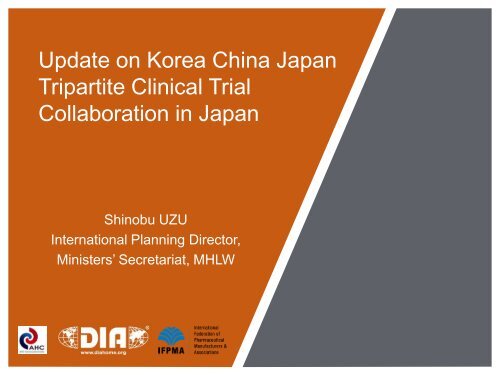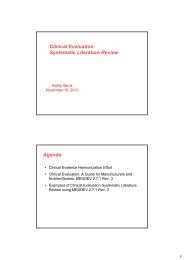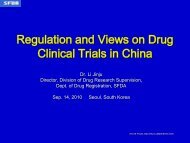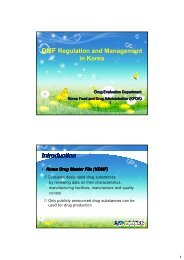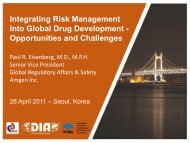Update on Korea China Japan Tripartite Clinical Trial ... - Apec-ahc.org
Update on Korea China Japan Tripartite Clinical Trial ... - Apec-ahc.org
Update on Korea China Japan Tripartite Clinical Trial ... - Apec-ahc.org
Create successful ePaper yourself
Turn your PDF publications into a flip-book with our unique Google optimized e-Paper software.
<str<strong>on</strong>g>Update</str<strong>on</strong>g> <strong>on</strong> <strong>Korea</strong> <strong>China</strong> <strong>Japan</strong><br />
<strong>Tripartite</strong> <strong>Clinical</strong> <strong>Trial</strong><br />
Collaborati<strong>on</strong> in <strong>Japan</strong><br />
Shinobu UZU<br />
Internati<strong>on</strong>al Planning Director,<br />
Ministers’ Secretariat, MHLW
Numbers of All CTN<br />
Trends of MRCTs Including <strong>Japan</strong> (1/2)<br />
- % of MRCTs in <strong>Clinical</strong> <strong>Trial</strong> Notificati<strong>on</strong>s -<br />
300<br />
250<br />
200<br />
150<br />
100<br />
50<br />
0<br />
Early<br />
FY2007<br />
(Apr-Sep)<br />
: Total number of <strong>Clinical</strong> <strong>Trial</strong> Notificati<strong>on</strong> (CTN)<br />
: Number of MRCT CTN<br />
Late Early Late Early<br />
FY2007 FY2008 FY2008 FY2009<br />
(Oct-Mar) (Apr-Sep) (Oct-Mar) (Apr-Sep)<br />
Late<br />
FY2009<br />
(Oct-Mar)<br />
Early<br />
FY2010<br />
(Apr-Jul)<br />
25<br />
20<br />
15<br />
10<br />
5<br />
0<br />
% of MRCTs
Trends of MRCTs including <strong>Japan</strong> (2/2)<br />
- Operati<strong>on</strong>al Regi<strong>on</strong>s of MRCTs in FY2009 -<br />
<strong>Japan</strong>+US/EU<br />
Unknown<br />
15.0%<br />
16.8%<br />
FY2009<br />
12.4%<br />
55.8%<br />
East-Asia Only<br />
World-Wide<br />
3
Ethnic Factors<br />
-Dose Difference by Regi<strong>on</strong>-<br />
For 32 % of drugs, US/EU dose was > 2 times higher than <strong>Japan</strong>ese dose<br />
Approved drugs in 2001-2007<br />
Arnold FL et al , Clin Pharmaco Therapeut., 87: 714-720, 2010<br />
4
ILD <strong>on</strong> Temsirolimus <strong>Clinical</strong> <strong>Trial</strong><br />
Number<br />
of ILD -1<br />
Number<br />
of ILD -2<br />
MRCT Phase II (<strong>Japan</strong>-<strong>Korea</strong>- <strong>China</strong>) MRCT Phase III<br />
North-South America, EU<br />
<strong>Japan</strong>ese <strong>Korea</strong>n Chinese Total IFN<br />
8/20<br />
40.0%<br />
11/20<br />
55.0%<br />
3/30<br />
10.0%<br />
16/29<br />
55.2%<br />
4/32<br />
12.5%<br />
18/28<br />
64.3%<br />
ILD 1 :Reported by investigator<br />
ILD 2 : Reviewed by ILD advisory board<br />
15/82<br />
18.3%<br />
45/77<br />
58.4%<br />
1/200<br />
0.5%<br />
8/138<br />
5.8%<br />
4/208<br />
1.9%<br />
52/178<br />
29.2%<br />
by <strong>Japan</strong>’s Review Report <strong>on</strong> Temsirolimus<br />
5
Promoti<strong>on</strong> of MRCT in East-Asia<br />
Background:<br />
- Globalizati<strong>on</strong> of Drug Development<br />
- The necessity of evaluati<strong>on</strong> <strong>on</strong> ethnic factors<br />
- East Asian Advantage<br />
•Ethnic Similarities am<strong>on</strong>g East-Asia<br />
(<strong>China</strong>/<strong>Korea</strong>/<strong>Japan</strong>)<br />
•Improvement of clinical trial envir<strong>on</strong>ment in East-Asia<br />
•Emerging drug market in East-Asia<br />
Better drugs can be rapidly<br />
through promoting MRCT in East-Asia.<br />
Regulatory collaborati<strong>on</strong> am<strong>on</strong>g <strong>China</strong>/<strong>Korea</strong>/<strong>Japan</strong><br />
Development of c<strong>on</strong>siderati<strong>on</strong>/guideline to c<strong>on</strong>duct<br />
MRCT in East-Asia
<strong>Japan</strong>’s Activities <strong>on</strong> Ethnic Factor<br />
Research<br />
1. Retrospective Literature Study<br />
FY2008: Collecting available PK data of Chinese, <strong>Korea</strong>n and <strong>Japan</strong><br />
and review the data<br />
2. Prospective PK study<br />
<strong>Clinical</strong><br />
Data<br />
FY2009-2010: C<strong>on</strong>ducting Prospective PK study Including<br />
Chinese, <strong>Korea</strong>n and <strong>Japan</strong>ese in order to compare ethnic<br />
difference more precisely<br />
• Budget: approximately total 400M Yen (=4M $ )<br />
PK Data <strong>Clinical</strong><br />
Data<br />
<strong>Clinical</strong><br />
Data<br />
• PK for three marketed drugs are measured by validated methods
Ethnic Difference in Pharmacokinetics<br />
<strong>Japan</strong>ese<br />
Intrinsic Factors Extrinsic Factors<br />
Ethnic Difference in PK<br />
<strong>Korea</strong>n<br />
Caucasian<br />
Chinese<br />
8
Summary of PK data analysis<br />
Ethnic Factors in PK from Literature Study<br />
No ethnic difference am<strong>on</strong>g 4 populati<strong>on</strong>s<br />
No ethnic difference am<strong>on</strong>g East Asian populati<strong>on</strong>s<br />
Difference between East Asian and Caucasian<br />
Ethnic difference am<strong>on</strong>g East Asian populati<strong>on</strong>s<br />
Difference between <strong>Japan</strong>ese and Caucasian<br />
No difference between <strong>Japan</strong>ese and Caucasian<br />
Drug Informati<strong>on</strong> Associati<strong>on</strong> www.diahome.<strong>org</strong> 9
<strong>Clinical</strong> Pharmacokinetic Study in East<br />
Asians and Caucasian (Kawai Project)<br />
Moxifloxacin; <strong>Japan</strong>ese East Asians and Caucasians<br />
Simvastatin; <strong>Japan</strong>ese Caucasians<br />
Meloxicam; <strong>Japan</strong>ese Chinese<br />
Same protocol (Practical circumstances)<br />
Standard operati<strong>on</strong> manual<br />
Analytical method for the plasma drug c<strong>on</strong>centrati<strong>on</strong><br />
Analysis site for the plasma drug c<strong>on</strong>centrati<strong>on</strong>s<br />
Drug form<br />
Health Labour Sciences Research Grant (Kawai Project)<br />
Drug Informati<strong>on</strong> Associati<strong>on</strong> www.diahome.<strong>org</strong> 10
Relative AUC difference<br />
Moxifloxacin Pharmacokinetic Study in East<br />
Asians and Caucasian<br />
Retrospective Study Data<br />
0.2<br />
0<br />
-0.2<br />
-0.4<br />
-0.6<br />
Chinese Caucasian<br />
Compared with <strong>Japan</strong>ese<br />
90%CI<br />
Kawai Project Data<br />
(Relative AUC difference)<br />
Chinese <strong>Korea</strong>n Caucasian<br />
Compared with <strong>Japan</strong>ese<br />
Health Labour Sciences Research Grant (Kawai Project)<br />
Drug Informati<strong>on</strong> Associati<strong>on</strong> www.diahome.<strong>org</strong> 11<br />
Relative AUCinf difference<br />
0.4<br />
0.2<br />
0<br />
-0.2<br />
-0.4
<strong>China</strong>, <strong>Japan</strong>, <strong>Korea</strong> <strong>Tripartite</strong> Cooperati<strong>on</strong><br />
- Related Activities in This Year -<br />
1. <strong>China</strong>, <strong>Japan</strong>, <strong>Korea</strong> <strong>Tripartite</strong> Meeting, Oct. 2011<br />
Research Group for ethnic factors<br />
Director General Meeting<br />
2. MRCT Tokyo Symposium, Nov.2011<br />
Key issues to be identified in “Seoul Symposium 2010” will be<br />
discussed further.<br />
To Develop recommendati<strong>on</strong> for next step<br />
3. Develop <strong>Japan</strong>’s “c<strong>on</strong>siderati<strong>on</strong>” for MRCT am<strong>on</strong>g East Asia,<br />
c<strong>on</strong>sidering Ethnic Factors<br />
Drug Informati<strong>on</strong> Associati<strong>on</strong> www.diahome.<strong>org</strong> 12
APEC LSIF (Life Science Innovati<strong>on</strong> Forum)<br />
Source: APEC<br />
Leaders Meeting<br />
Ministerial Meeting<br />
Senior Officials Meeting<br />
Committee <strong>on</strong><br />
Trade and Investment<br />
LSIF<br />
Regulatory Harm<strong>on</strong>izati<strong>on</strong><br />
Steering Committee (RHSC)<br />
Regulatory Members: Canada, <strong>China</strong>, <strong>Japan</strong>,<br />
<strong>Korea</strong>, Peru, Chinese Taipei, Thailand, US
APEC Multi-Regi<strong>on</strong>al <strong>Clinical</strong> <strong>Trial</strong> Workshop<br />
(Sep. 13-15, 2010, Seoul, <strong>Korea</strong>)<br />
写真<br />
Major issues<br />
• Study Design<br />
• Operati<strong>on</strong>al<br />
Aspects<br />
• <strong>Korea</strong>-<strong>China</strong>-<strong>Japan</strong><br />
Cooperati<strong>on</strong><br />
• Case Studies <strong>on</strong><br />
Oncology<br />
• Panel Discussi<strong>on</strong><br />
14
1. Overall<br />
Recommendati<strong>on</strong>s<br />
A) MRCTWS should be c<strong>on</strong>tinued <strong>on</strong> MRCT<br />
Roadmap<br />
B) <strong>China</strong>-<strong>Japan</strong>-<strong>Korea</strong> Cooperati<strong>on</strong>: valuable effort<br />
for entire APEC Regi<strong>on</strong><br />
2. Study Design (statistical point of view)<br />
A) In order to reduce variance of data, involvement of<br />
the regi<strong>on</strong> in questi<strong>on</strong> in early stage is important.<br />
3. Operati<strong>on</strong>al Aspects<br />
A) Trainings for CRCs, principal investigators and<br />
support staff are urgently needed 15
Roadmap to promote MRCT<br />
Goal:To facilitate MRCTs and acceptance of MRCT results for<br />
drug review by regulatory authorities in APEC regi<strong>on</strong>s<br />
Overview:<br />
Evaluate current practices relative to internati<strong>on</strong>al best practices<br />
Establish comm<strong>on</strong> understanding regarding the following key issues<br />
and other issues within APEC regi<strong>on</strong> under the auspices of LSIF.<br />
[Key Issues]<br />
- Implementati<strong>on</strong> of ICH E5 guideline<br />
- Study design of MRCT<br />
- Operati<strong>on</strong>al/Regulatory procedure to facilitate MRCT efficiently<br />
- Cooperative regulatory approach to facilitate MRCTs <strong>on</strong> diseases prevalent in subregi<strong>on</strong>s<br />
of APEC.<br />
Implement training for those involved in MRCT<br />
Develop necessary items for Training/Workshop to promote MRCT<br />
- APEC ec<strong>on</strong>omies share best practices<br />
- MRCTWS as well as each ec<strong>on</strong>omy c<strong>on</strong>siders developing training curricula<br />
Issue recommendati<strong>on</strong> <strong>on</strong> regulatory harm<strong>on</strong>izati<strong>on</strong> regarding MRCT<br />
RHSC will support the activities and development of recommendati<strong>on</strong><br />
for next step.
Asia’s Role in Global Drug Development<br />
EU<br />
East Asia<br />
<strong>Japan</strong><br />
ASIA<br />
ASEAN<br />
APEC<br />
North America<br />
USA<br />
Canada
Back up<br />
Drug Informati<strong>on</strong> Associati<strong>on</strong> www.diahome.<strong>org</strong> 18
国際共同試験での日本人の情報<br />
【エベロリムス(審査報告書より)】<br />
• 日本人を含む国際共同第Ⅲ相試験(試験番号2240)
C<strong>on</strong>siderati<strong>on</strong> of Ethnic Factors<br />
Intrinsic Factors<br />
Body weight (Rosiglitaz<strong>on</strong>e)<br />
Genotype of drug metabolizing enzymes (Omeprazole and<br />
Tolterodine etc.)<br />
Genotype of drug transporter (Statins)<br />
Metabolized by CYP3A4/5 (Nifedipiene and Simvastatin etc.)<br />
Renal functi<strong>on</strong> (Fluc<strong>on</strong>azole)<br />
Extrinsic Factors (Practical circumstances)<br />
Protocol (subjects, operati<strong>on</strong>, meal, etc.)<br />
Analytical method and sites<br />
Ethnic Factors in PK from Literature Study<br />
Drug Informati<strong>on</strong> Associati<strong>on</strong> www.diahome.<strong>org</strong> 20
Ethnic Difference in Pharmacokinetics<br />
Caffeine (CYP1A2)<br />
Pioglitaz<strong>on</strong>e (CYP2C8)<br />
Tolbutamide (CYP2C9)<br />
Omeprazole (CYP2C19)<br />
Lansoprazole (CYP2C19)<br />
Nortriptyline (CYP2D6)<br />
Retrospective Literature Study<br />
Nifedipine (CYP3A4/5)<br />
Nicotine (CYP2A6) Amlodipine (CYP3A4/5)<br />
Rosiglitaz<strong>on</strong>e (CYP2C8)<br />
Meloxicam (CYP2C9)<br />
Tolterodine (CYP2D6)<br />
Sorafenib (CYP3A4, UGT1A9)<br />
Rosuvastatin (OATP1B1)<br />
Simvastatin (CYP3A4/5, OATP1B1)<br />
Moxfloxacin (UGT1A1, SULT2A1)<br />
Ranitidene (Renal excreti<strong>on</strong>)<br />
Fluc<strong>on</strong>azole (Renal excreti<strong>on</strong>)<br />
21
Globalizati<strong>on</strong> of <strong>Clinical</strong> <strong>Trial</strong>s<br />
<strong>Japan</strong><br />
15.7; 10.3%<br />
Nature Rev Drug Discovery, 7: 13, 2008
Difference am<strong>on</strong>g East<br />
Asian populati<strong>on</strong>s<br />
PK Data of <strong>Japan</strong>ese, <strong>Korea</strong>ns, Chinese, and Caucasians<br />
Difference between <strong>Japan</strong>ese<br />
and Caucasians<br />
Comparing <strong>Japan</strong>ese and Caucasians<br />
No difference am<strong>on</strong>g East<br />
Asian populati<strong>on</strong>s<br />
No difference between <strong>Japan</strong>ese<br />
and Caucasians<br />
Comparing am<strong>on</strong>g East Asians Comparing am<strong>on</strong>g East Asians<br />
Difference am<strong>on</strong>g East<br />
Asian populati<strong>on</strong>s<br />
No difference am<strong>on</strong>g<br />
East Asian populati<strong>on</strong>s<br />
23


